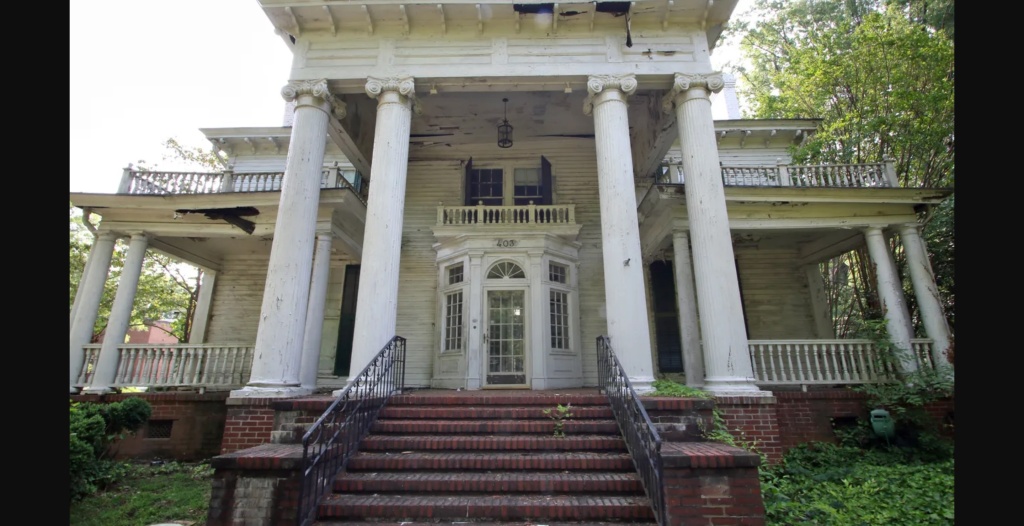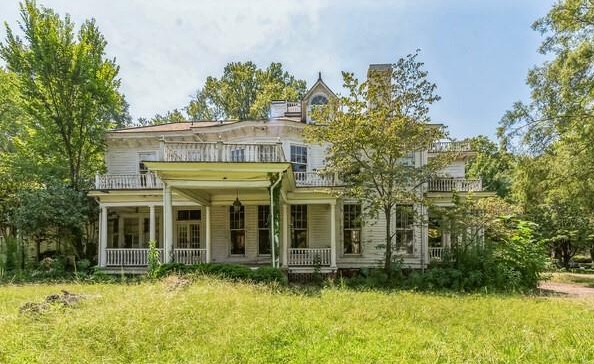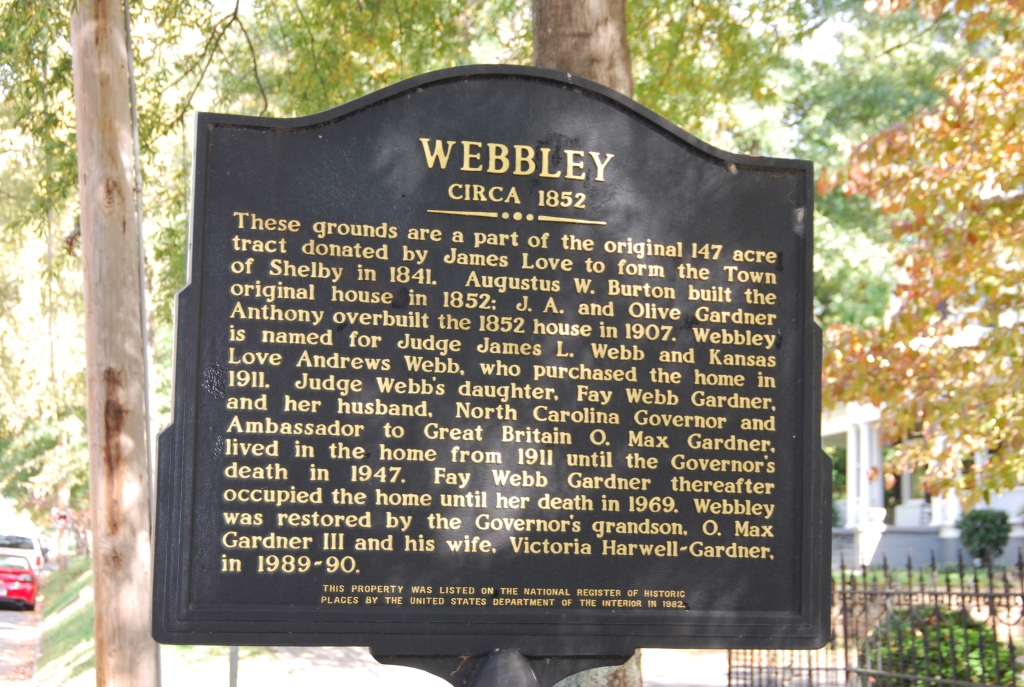(The first photo above is by Mike Hensdill of The Gastonia Gazette via The Shelby Star.)
The home of one of North Carolina’s most prominent governors is in sad shape. Although it’s listed on the National Register, the mansion has fallen into disrepair. It’s for sale at $396,700, a lot of money but a reasonable $58 per square foot. It’s a landmark worth saving.
Oliver Max Gardner was one of the most significant governors of North Carolina in the 20th century, and the house “is one of the most distinguished residences in the town of Shelby,” its National Register nomination says. Built around 1850, it has 6 bedrooms, 8 full bathrooms and 1 half-bathroom in 6,813 square feet (per county records). It sits well back from the street on a large 2.43-acre lot. In addition to being on the National Register in its own right, it’s in the Central Shelby Historic District on the National Register.
“The house is an early twentieth century overbuilding of a mid-nineteenth century Italianate dwelling, and though remnants of the earlier structure can be seen in places, the house is of thoroughgoing Colonial Revival character … here fully developed in one of the most striking examples of the style in western North Carolina,” its National Register nomination says.
It was built about 1852 for lawyer Augustus Burton. The rest of its history is wrapped up in the Gardner family. Max’s sister Mary Olive and brother-in-law J.A. Anthony bought it in 1905 and expanded it to its present size. Max’s father-in-law, Judge James L. Webb, bought it 1911. He named it Webbley, and made it home for him and his wife and for daughter Fay Lamar Webb Gardner (1886-1969) and Max (1882-1947). Max never actually owned the house (his wife did after her parents died), although it was nominally his home for 36 years, along with the Governor’s Mansion for four years and a residence in D.C. for 25.
The property includes a servants’ quarters and a two-story garage.
“In May of 1993, O. Max Gardner III and his wife, Victoria Harwell Gardner, turned the home into a bed and breakfast with a political theme. The Inn at Webbly was one of the nation’s finest inns, but closed in 1998 due to an illness in the family which made operation of the inn difficult,” National Park Service says. The house remained in the Gardner family until a foreclosure in 2023.
It was listed for sale at $1.6 million in 2017, but didn’t sell. An auction in 2023 put it into its lender’s hands. How it looked in better days (from TripAdvisor and GetLostintheUSA.com):
Oliver Maxwell Gardner
Max was one of the most notable governors of North Carolina in the 20th century. Granted, that’s not a very high standard, but he actually was a pretty significant figure.

He was born in Shelby, the youngest of 12 children. His father was a doctor who had served in the legislature as an anti-secessionist. Max majored in chemistry at N.C. A&M in Raleigh, played on the football team and was president of his class. After graduating, he taught chemistry in Raleigh while reading law. He went to law school in Chapel Hill, where he again played football. Before starting to practice law, he was the football coach at Hampden-Sydney College in Virginia.
Max became a central figure in a political dynasty based in Shelby. His father-in-law, Judge Webb, had a brother who was a judge. Max’s sister Bess married the wonderfully named Clyde R. Hoey, who owned the local newspaper and was elected governor and U.S. senator.
“Gardner was a handsome man, six feet two inches tall with broad shoulders and ruddy complexion; a fascinating storyteller; and fond of good food and drink,” NCpedia says. “Although tactful and pragmatic, he was ready to stand on principle and to defend his position brilliantly and loudly. He established himself as North Carolina’s most influential politician by an ability to make and retain friends, by shrewd appointments and an effective centralization program while governor, and by his strength and probity of character.
“He was a successful lawyer and businessman (he sold his principal mill in Shelby for more than $3 million in 1946); yet he fought for improved labor conditions, scientific agriculture, the elimination of tenant farming, and more equitable race relations. While in Washington, he was a popular and influential personality moving easily in the company of businessmen and bureaucrats, newspapermen, congressmen, and presidents. Withal he had the virtue of modesty, which made him uncomfortable, for example, when his favorite philanthropy, Boiling Springs Junior College, was renamed Gardner-Webb College.”
Gardner was governor from 1929 to 1933 and had been a state senator and lieutenant governor before that. He won national praise for his handling of textile-mill strikes in 1929, expressing the dangerously radical views that even Communists deserve protection under the law and that “we cannot build a prosperous citizenship on low wages.” On the other hand, he was a vocal supporter of the disaster of Prohibition, “the last great battle against the drink evil in our state,” he said.
He accomplished much despite the Depression and the 21st Amendment. He kept the state solvent during the nation’s worst financial disaster, created the consolidated University of North Carolina (then composed of Chapel Hill, State College and the Women’s College) and moved responsibility for highways from the counties to the state. He even made such progressive changes as increasing corporate taxes.
After serving the single term that governors were then allowed in the state, Gardner went to Washington as a lawyer and lobbyist. He became an ally and advisor of President Roosevelt. Roosevelt appointed him chairman of the Advisory Board of the Office of War Mobilization and Reconversion; President Truman made him as undersecretary of the Treasury. He was named ambassador to Great Britain but died before he could go. Few North Carolina governors before or since have merited that kind of national stature. Luther Hodges and Terry Sanford come to mind, but who else? Consider our last three ex-governors, or, better yet, let’s try to forget them.
403 S. Washington Street, Shelby, Cleveland County
Webbley, the O. Max Gardner House
- $396,700 (originally $461,300)
- 6 bedrooms, 8 full bathrooms, 1 half-bathroom, 6,813 square feet (per county), 2.43 acres
- Price/square foot: $58
- Built in 1850
- Listed September 21, 2023
- Last sale: $758,893, July 2023 (foreclosure)
- Neighborhood: Central Shelby Historic District (NR)
- Note: The listing shows 7,406 square feet.












